An Evaluation of Enterprise Systems and Integrated Business Processes
VerifiedAdded on 2021/04/21
|12
|3209
|308
Report
AI Summary
This report provides an in-depth analysis of Enterprise Resource Planning (ERP) systems and their integration with various business processes. It begins by examining the evolution of ERP systems, from early inventory management to modern cloud-based solutions, and discusses the suitability of different activities for ERP implementation, including customer relationship management, finance, and manufacturing. The report then explores strategic considerations for businesses, such as analyzing competitors, new market entrants, and customer power, along with the use of Business Process Model and Notation (BPMN) diagrams for process visualization. Furthermore, it delves into case studies, comparing the implementation of SAP ERP systems and the challenges faced, while also highlighting the advantages of SAP over other systems. The report concludes by examining dynamic business processes and the strategic importance of establishing customer and supplier relationships in the context of ERP systems and collaborative information systems, emphasizing the role of communication and information utilization in achieving business goals.
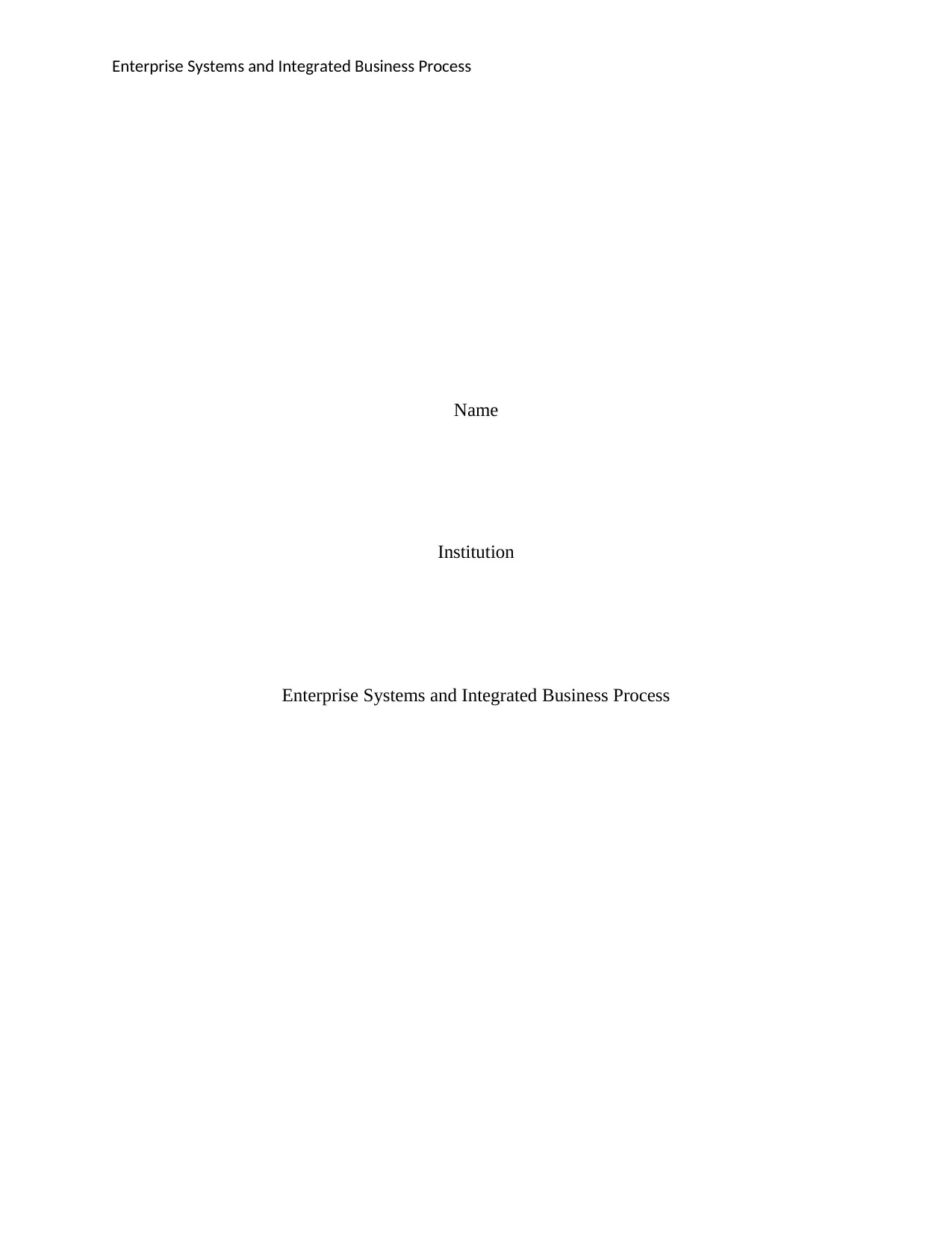
Enterprise Systems and Integrated Business Process
Name
Institution
Enterprise Systems and Integrated Business Process
Name
Institution
Enterprise Systems and Integrated Business Process
Paraphrase This Document
Need a fresh take? Get an instant paraphrase of this document with our AI Paraphraser
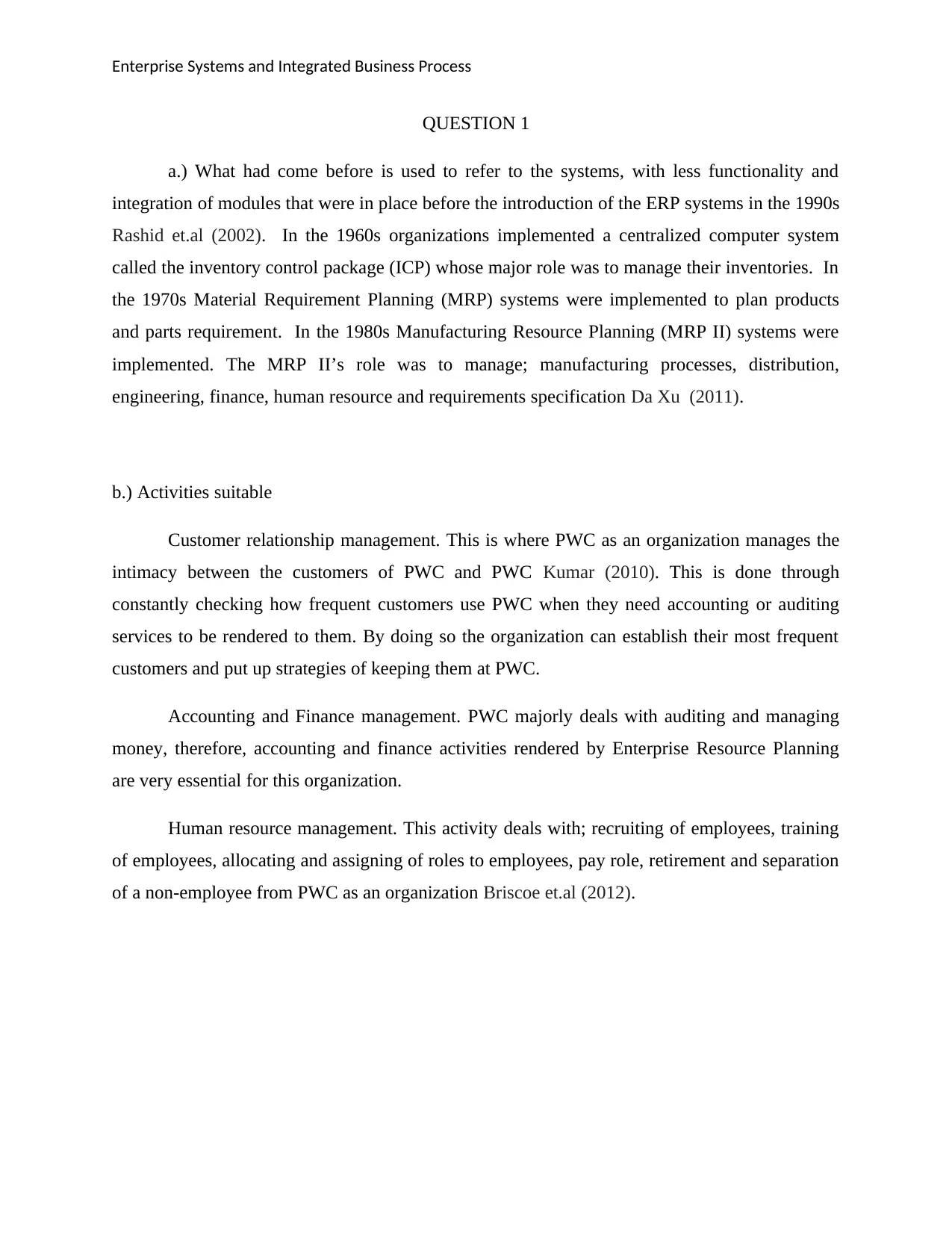
Enterprise Systems and Integrated Business Process
QUESTION 1
a.) What had come before is used to refer to the systems, with less functionality and
integration of modules that were in place before the introduction of the ERP systems in the 1990s
Rashid et.al (2002). In the 1960s organizations implemented a centralized computer system
called the inventory control package (ICP) whose major role was to manage their inventories. In
the 1970s Material Requirement Planning (MRP) systems were implemented to plan products
and parts requirement. In the 1980s Manufacturing Resource Planning (MRP II) systems were
implemented. The MRP II’s role was to manage; manufacturing processes, distribution,
engineering, finance, human resource and requirements specification Da Xu (2011).
b.) Activities suitable
Customer relationship management. This is where PWC as an organization manages the
intimacy between the customers of PWC and PWC Kumar (2010). This is done through
constantly checking how frequent customers use PWC when they need accounting or auditing
services to be rendered to them. By doing so the organization can establish their most frequent
customers and put up strategies of keeping them at PWC.
Accounting and Finance management. PWC majorly deals with auditing and managing
money, therefore, accounting and finance activities rendered by Enterprise Resource Planning
are very essential for this organization.
Human resource management. This activity deals with; recruiting of employees, training
of employees, allocating and assigning of roles to employees, pay role, retirement and separation
of a non-employee from PWC as an organization Briscoe et.al (2012).
QUESTION 1
a.) What had come before is used to refer to the systems, with less functionality and
integration of modules that were in place before the introduction of the ERP systems in the 1990s
Rashid et.al (2002). In the 1960s organizations implemented a centralized computer system
called the inventory control package (ICP) whose major role was to manage their inventories. In
the 1970s Material Requirement Planning (MRP) systems were implemented to plan products
and parts requirement. In the 1980s Manufacturing Resource Planning (MRP II) systems were
implemented. The MRP II’s role was to manage; manufacturing processes, distribution,
engineering, finance, human resource and requirements specification Da Xu (2011).
b.) Activities suitable
Customer relationship management. This is where PWC as an organization manages the
intimacy between the customers of PWC and PWC Kumar (2010). This is done through
constantly checking how frequent customers use PWC when they need accounting or auditing
services to be rendered to them. By doing so the organization can establish their most frequent
customers and put up strategies of keeping them at PWC.
Accounting and Finance management. PWC majorly deals with auditing and managing
money, therefore, accounting and finance activities rendered by Enterprise Resource Planning
are very essential for this organization.
Human resource management. This activity deals with; recruiting of employees, training
of employees, allocating and assigning of roles to employees, pay role, retirement and separation
of a non-employee from PWC as an organization Briscoe et.al (2012).
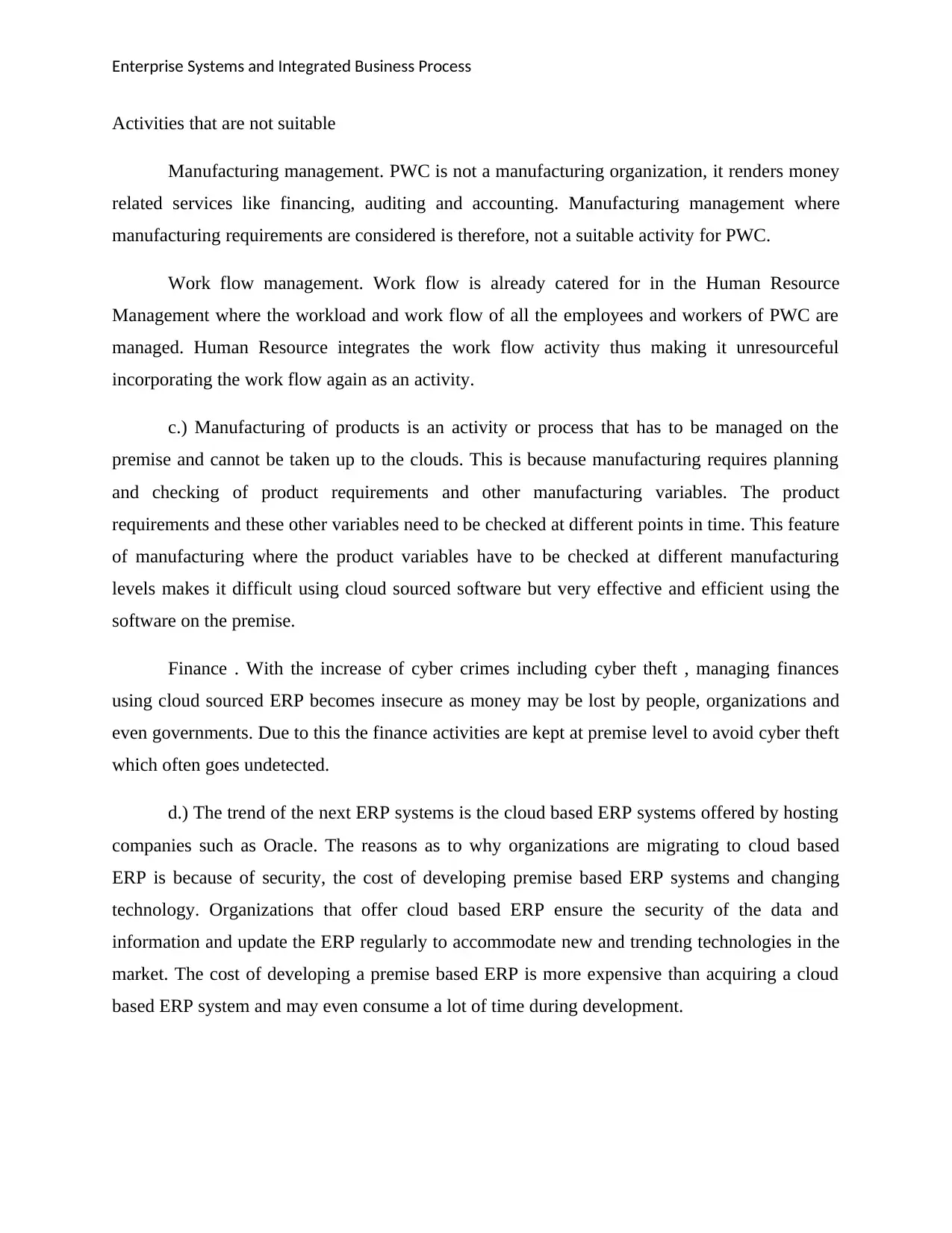
Enterprise Systems and Integrated Business Process
Activities that are not suitable
Manufacturing management. PWC is not a manufacturing organization, it renders money
related services like financing, auditing and accounting. Manufacturing management where
manufacturing requirements are considered is therefore, not a suitable activity for PWC.
Work flow management. Work flow is already catered for in the Human Resource
Management where the workload and work flow of all the employees and workers of PWC are
managed. Human Resource integrates the work flow activity thus making it unresourceful
incorporating the work flow again as an activity.
c.) Manufacturing of products is an activity or process that has to be managed on the
premise and cannot be taken up to the clouds. This is because manufacturing requires planning
and checking of product requirements and other manufacturing variables. The product
requirements and these other variables need to be checked at different points in time. This feature
of manufacturing where the product variables have to be checked at different manufacturing
levels makes it difficult using cloud sourced software but very effective and efficient using the
software on the premise.
Finance . With the increase of cyber crimes including cyber theft , managing finances
using cloud sourced ERP becomes insecure as money may be lost by people, organizations and
even governments. Due to this the finance activities are kept at premise level to avoid cyber theft
which often goes undetected.
d.) The trend of the next ERP systems is the cloud based ERP systems offered by hosting
companies such as Oracle. The reasons as to why organizations are migrating to cloud based
ERP is because of security, the cost of developing premise based ERP systems and changing
technology. Organizations that offer cloud based ERP ensure the security of the data and
information and update the ERP regularly to accommodate new and trending technologies in the
market. The cost of developing a premise based ERP is more expensive than acquiring a cloud
based ERP system and may even consume a lot of time during development.
Activities that are not suitable
Manufacturing management. PWC is not a manufacturing organization, it renders money
related services like financing, auditing and accounting. Manufacturing management where
manufacturing requirements are considered is therefore, not a suitable activity for PWC.
Work flow management. Work flow is already catered for in the Human Resource
Management where the workload and work flow of all the employees and workers of PWC are
managed. Human Resource integrates the work flow activity thus making it unresourceful
incorporating the work flow again as an activity.
c.) Manufacturing of products is an activity or process that has to be managed on the
premise and cannot be taken up to the clouds. This is because manufacturing requires planning
and checking of product requirements and other manufacturing variables. The product
requirements and these other variables need to be checked at different points in time. This feature
of manufacturing where the product variables have to be checked at different manufacturing
levels makes it difficult using cloud sourced software but very effective and efficient using the
software on the premise.
Finance . With the increase of cyber crimes including cyber theft , managing finances
using cloud sourced ERP becomes insecure as money may be lost by people, organizations and
even governments. Due to this the finance activities are kept at premise level to avoid cyber theft
which often goes undetected.
d.) The trend of the next ERP systems is the cloud based ERP systems offered by hosting
companies such as Oracle. The reasons as to why organizations are migrating to cloud based
ERP is because of security, the cost of developing premise based ERP systems and changing
technology. Organizations that offer cloud based ERP ensure the security of the data and
information and update the ERP regularly to accommodate new and trending technologies in the
market. The cost of developing a premise based ERP is more expensive than acquiring a cloud
based ERP system and may even consume a lot of time during development.
⊘ This is a preview!⊘
Do you want full access?
Subscribe today to unlock all pages.

Trusted by 1+ million students worldwide
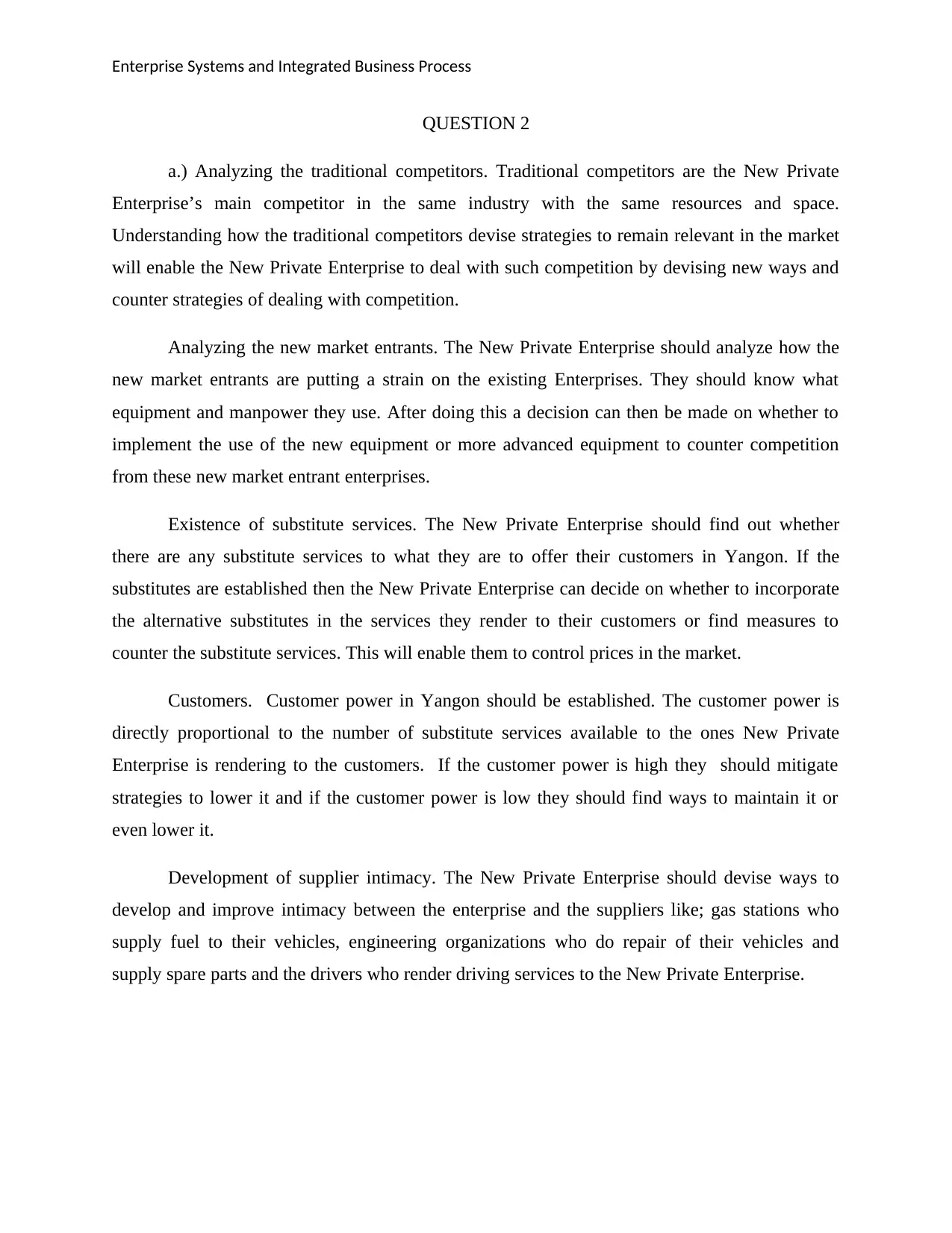
Enterprise Systems and Integrated Business Process
QUESTION 2
a.) Analyzing the traditional competitors. Traditional competitors are the New Private
Enterprise’s main competitor in the same industry with the same resources and space.
Understanding how the traditional competitors devise strategies to remain relevant in the market
will enable the New Private Enterprise to deal with such competition by devising new ways and
counter strategies of dealing with competition.
Analyzing the new market entrants. The New Private Enterprise should analyze how the
new market entrants are putting a strain on the existing Enterprises. They should know what
equipment and manpower they use. After doing this a decision can then be made on whether to
implement the use of the new equipment or more advanced equipment to counter competition
from these new market entrant enterprises.
Existence of substitute services. The New Private Enterprise should find out whether
there are any substitute services to what they are to offer their customers in Yangon. If the
substitutes are established then the New Private Enterprise can decide on whether to incorporate
the alternative substitutes in the services they render to their customers or find measures to
counter the substitute services. This will enable them to control prices in the market.
Customers. Customer power in Yangon should be established. The customer power is
directly proportional to the number of substitute services available to the ones New Private
Enterprise is rendering to the customers. If the customer power is high they should mitigate
strategies to lower it and if the customer power is low they should find ways to maintain it or
even lower it.
Development of supplier intimacy. The New Private Enterprise should devise ways to
develop and improve intimacy between the enterprise and the suppliers like; gas stations who
supply fuel to their vehicles, engineering organizations who do repair of their vehicles and
supply spare parts and the drivers who render driving services to the New Private Enterprise.
QUESTION 2
a.) Analyzing the traditional competitors. Traditional competitors are the New Private
Enterprise’s main competitor in the same industry with the same resources and space.
Understanding how the traditional competitors devise strategies to remain relevant in the market
will enable the New Private Enterprise to deal with such competition by devising new ways and
counter strategies of dealing with competition.
Analyzing the new market entrants. The New Private Enterprise should analyze how the
new market entrants are putting a strain on the existing Enterprises. They should know what
equipment and manpower they use. After doing this a decision can then be made on whether to
implement the use of the new equipment or more advanced equipment to counter competition
from these new market entrant enterprises.
Existence of substitute services. The New Private Enterprise should find out whether
there are any substitute services to what they are to offer their customers in Yangon. If the
substitutes are established then the New Private Enterprise can decide on whether to incorporate
the alternative substitutes in the services they render to their customers or find measures to
counter the substitute services. This will enable them to control prices in the market.
Customers. Customer power in Yangon should be established. The customer power is
directly proportional to the number of substitute services available to the ones New Private
Enterprise is rendering to the customers. If the customer power is high they should mitigate
strategies to lower it and if the customer power is low they should find ways to maintain it or
even lower it.
Development of supplier intimacy. The New Private Enterprise should devise ways to
develop and improve intimacy between the enterprise and the suppliers like; gas stations who
supply fuel to their vehicles, engineering organizations who do repair of their vehicles and
supply spare parts and the drivers who render driving services to the New Private Enterprise.
Paraphrase This Document
Need a fresh take? Get an instant paraphrase of this document with our AI Paraphraser
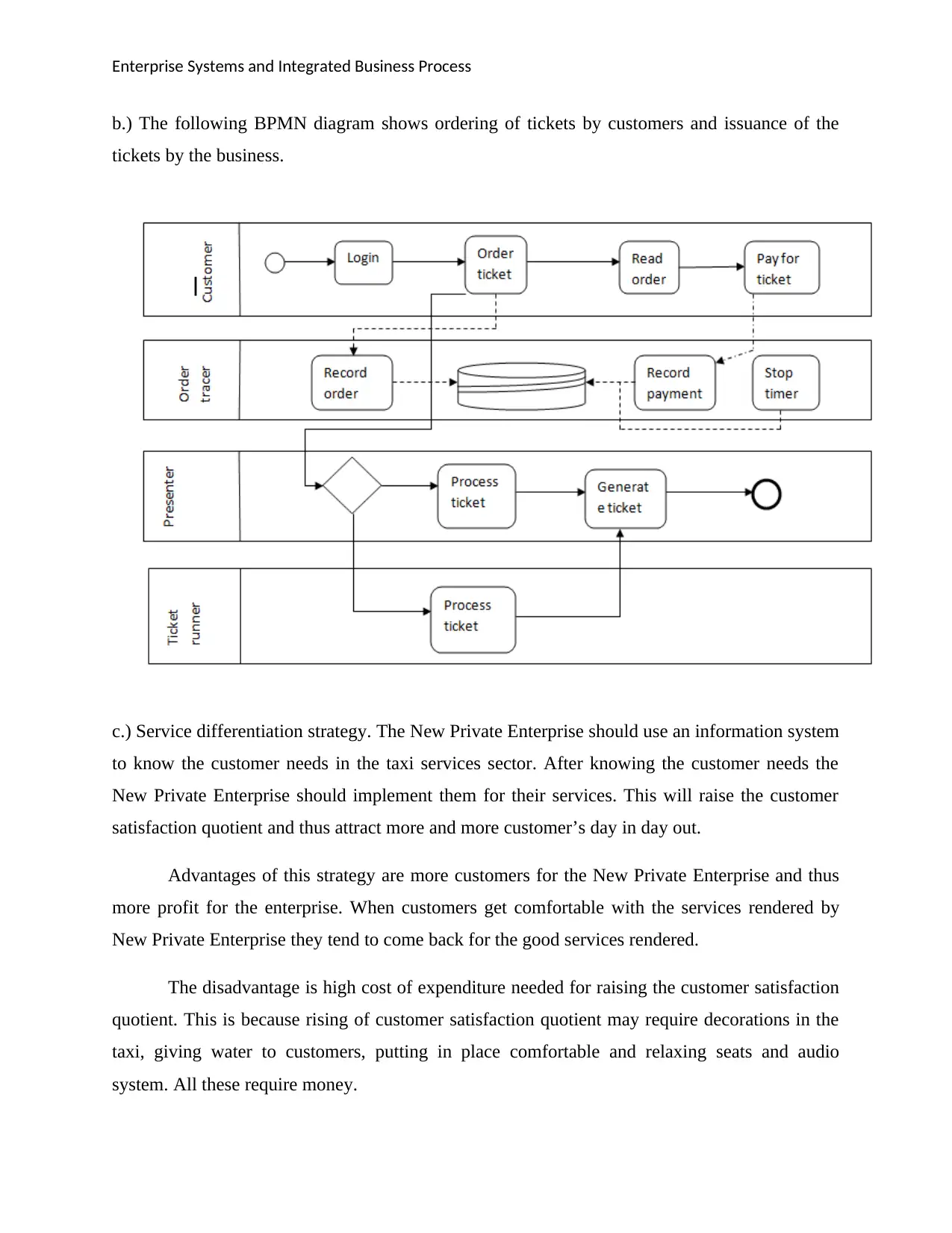
Enterprise Systems and Integrated Business Process
b.) The following BPMN diagram shows ordering of tickets by customers and issuance of the
tickets by the business.
c.) Service differentiation strategy. The New Private Enterprise should use an information system
to know the customer needs in the taxi services sector. After knowing the customer needs the
New Private Enterprise should implement them for their services. This will raise the customer
satisfaction quotient and thus attract more and more customer’s day in day out.
Advantages of this strategy are more customers for the New Private Enterprise and thus
more profit for the enterprise. When customers get comfortable with the services rendered by
New Private Enterprise they tend to come back for the good services rendered.
The disadvantage is high cost of expenditure needed for raising the customer satisfaction
quotient. This is because rising of customer satisfaction quotient may require decorations in the
taxi, giving water to customers, putting in place comfortable and relaxing seats and audio
system. All these require money.
b.) The following BPMN diagram shows ordering of tickets by customers and issuance of the
tickets by the business.
c.) Service differentiation strategy. The New Private Enterprise should use an information system
to know the customer needs in the taxi services sector. After knowing the customer needs the
New Private Enterprise should implement them for their services. This will raise the customer
satisfaction quotient and thus attract more and more customer’s day in day out.
Advantages of this strategy are more customers for the New Private Enterprise and thus
more profit for the enterprise. When customers get comfortable with the services rendered by
New Private Enterprise they tend to come back for the good services rendered.
The disadvantage is high cost of expenditure needed for raising the customer satisfaction
quotient. This is because rising of customer satisfaction quotient may require decorations in the
taxi, giving water to customers, putting in place comfortable and relaxing seats and audio
system. All these require money.
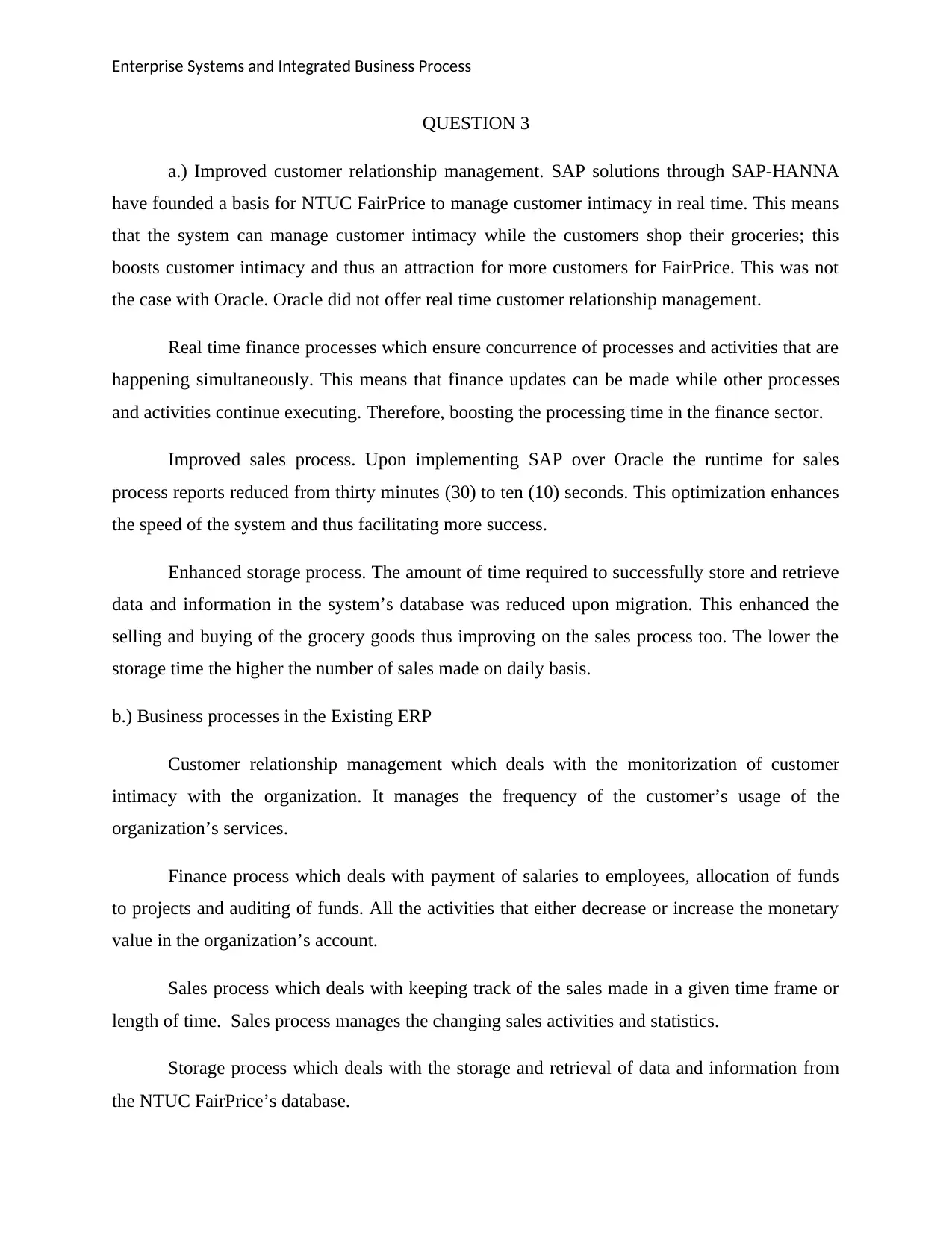
Enterprise Systems and Integrated Business Process
QUESTION 3
a.) Improved customer relationship management. SAP solutions through SAP-HANNA
have founded a basis for NTUC FairPrice to manage customer intimacy in real time. This means
that the system can manage customer intimacy while the customers shop their groceries; this
boosts customer intimacy and thus an attraction for more customers for FairPrice. This was not
the case with Oracle. Oracle did not offer real time customer relationship management.
Real time finance processes which ensure concurrence of processes and activities that are
happening simultaneously. This means that finance updates can be made while other processes
and activities continue executing. Therefore, boosting the processing time in the finance sector.
Improved sales process. Upon implementing SAP over Oracle the runtime for sales
process reports reduced from thirty minutes (30) to ten (10) seconds. This optimization enhances
the speed of the system and thus facilitating more success.
Enhanced storage process. The amount of time required to successfully store and retrieve
data and information in the system’s database was reduced upon migration. This enhanced the
selling and buying of the grocery goods thus improving on the sales process too. The lower the
storage time the higher the number of sales made on daily basis.
b.) Business processes in the Existing ERP
Customer relationship management which deals with the monitorization of customer
intimacy with the organization. It manages the frequency of the customer’s usage of the
organization’s services.
Finance process which deals with payment of salaries to employees, allocation of funds
to projects and auditing of funds. All the activities that either decrease or increase the monetary
value in the organization’s account.
Sales process which deals with keeping track of the sales made in a given time frame or
length of time. Sales process manages the changing sales activities and statistics.
Storage process which deals with the storage and retrieval of data and information from
the NTUC FairPrice’s database.
QUESTION 3
a.) Improved customer relationship management. SAP solutions through SAP-HANNA
have founded a basis for NTUC FairPrice to manage customer intimacy in real time. This means
that the system can manage customer intimacy while the customers shop their groceries; this
boosts customer intimacy and thus an attraction for more customers for FairPrice. This was not
the case with Oracle. Oracle did not offer real time customer relationship management.
Real time finance processes which ensure concurrence of processes and activities that are
happening simultaneously. This means that finance updates can be made while other processes
and activities continue executing. Therefore, boosting the processing time in the finance sector.
Improved sales process. Upon implementing SAP over Oracle the runtime for sales
process reports reduced from thirty minutes (30) to ten (10) seconds. This optimization enhances
the speed of the system and thus facilitating more success.
Enhanced storage process. The amount of time required to successfully store and retrieve
data and information in the system’s database was reduced upon migration. This enhanced the
selling and buying of the grocery goods thus improving on the sales process too. The lower the
storage time the higher the number of sales made on daily basis.
b.) Business processes in the Existing ERP
Customer relationship management which deals with the monitorization of customer
intimacy with the organization. It manages the frequency of the customer’s usage of the
organization’s services.
Finance process which deals with payment of salaries to employees, allocation of funds
to projects and auditing of funds. All the activities that either decrease or increase the monetary
value in the organization’s account.
Sales process which deals with keeping track of the sales made in a given time frame or
length of time. Sales process manages the changing sales activities and statistics.
Storage process which deals with the storage and retrieval of data and information from
the NTUC FairPrice’s database.
⊘ This is a preview!⊘
Do you want full access?
Subscribe today to unlock all pages.

Trusted by 1+ million students worldwide
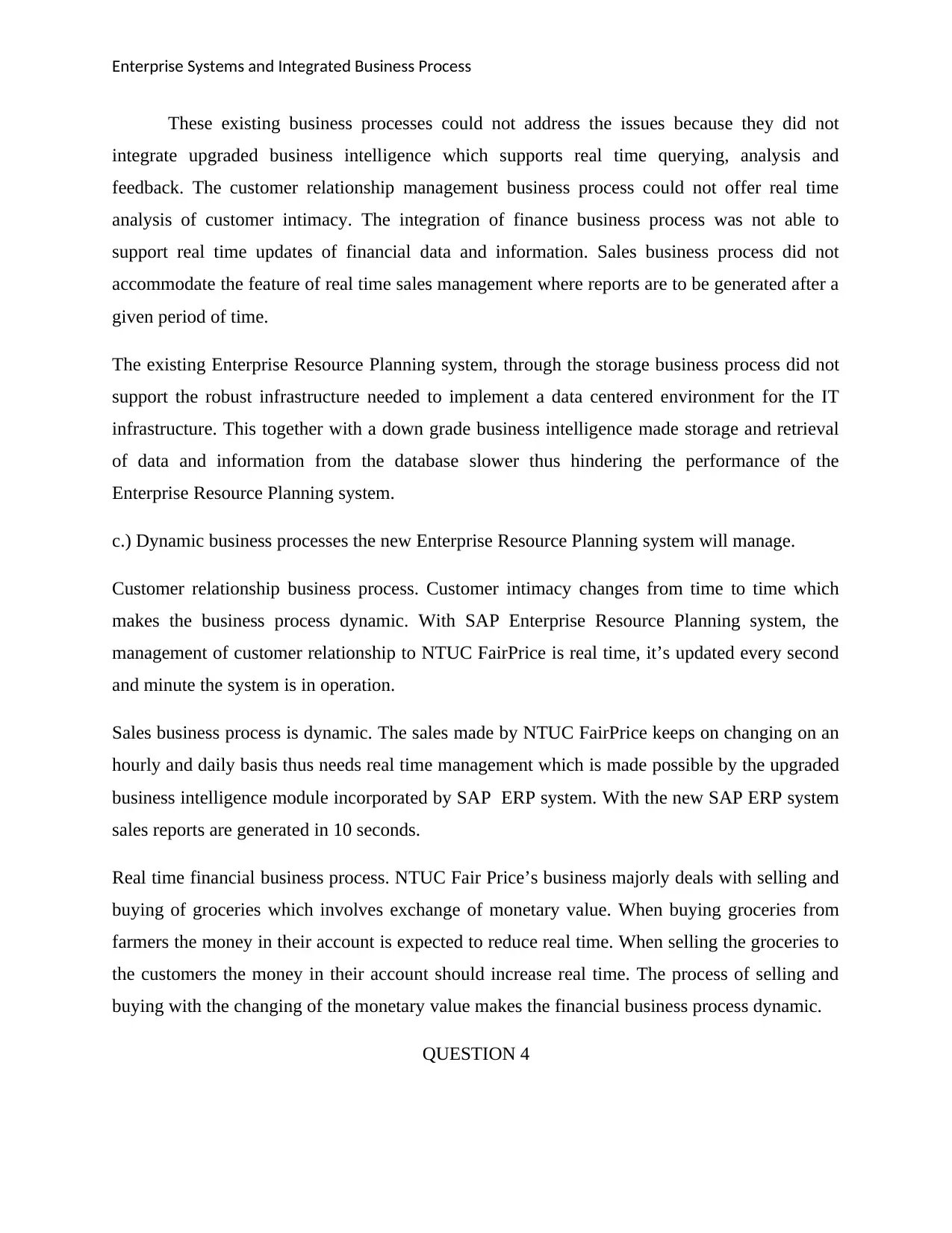
Enterprise Systems and Integrated Business Process
These existing business processes could not address the issues because they did not
integrate upgraded business intelligence which supports real time querying, analysis and
feedback. The customer relationship management business process could not offer real time
analysis of customer intimacy. The integration of finance business process was not able to
support real time updates of financial data and information. Sales business process did not
accommodate the feature of real time sales management where reports are to be generated after a
given period of time.
The existing Enterprise Resource Planning system, through the storage business process did not
support the robust infrastructure needed to implement a data centered environment for the IT
infrastructure. This together with a down grade business intelligence made storage and retrieval
of data and information from the database slower thus hindering the performance of the
Enterprise Resource Planning system.
c.) Dynamic business processes the new Enterprise Resource Planning system will manage.
Customer relationship business process. Customer intimacy changes from time to time which
makes the business process dynamic. With SAP Enterprise Resource Planning system, the
management of customer relationship to NTUC FairPrice is real time, it’s updated every second
and minute the system is in operation.
Sales business process is dynamic. The sales made by NTUC FairPrice keeps on changing on an
hourly and daily basis thus needs real time management which is made possible by the upgraded
business intelligence module incorporated by SAP ERP system. With the new SAP ERP system
sales reports are generated in 10 seconds.
Real time financial business process. NTUC Fair Price’s business majorly deals with selling and
buying of groceries which involves exchange of monetary value. When buying groceries from
farmers the money in their account is expected to reduce real time. When selling the groceries to
the customers the money in their account should increase real time. The process of selling and
buying with the changing of the monetary value makes the financial business process dynamic.
QUESTION 4
These existing business processes could not address the issues because they did not
integrate upgraded business intelligence which supports real time querying, analysis and
feedback. The customer relationship management business process could not offer real time
analysis of customer intimacy. The integration of finance business process was not able to
support real time updates of financial data and information. Sales business process did not
accommodate the feature of real time sales management where reports are to be generated after a
given period of time.
The existing Enterprise Resource Planning system, through the storage business process did not
support the robust infrastructure needed to implement a data centered environment for the IT
infrastructure. This together with a down grade business intelligence made storage and retrieval
of data and information from the database slower thus hindering the performance of the
Enterprise Resource Planning system.
c.) Dynamic business processes the new Enterprise Resource Planning system will manage.
Customer relationship business process. Customer intimacy changes from time to time which
makes the business process dynamic. With SAP Enterprise Resource Planning system, the
management of customer relationship to NTUC FairPrice is real time, it’s updated every second
and minute the system is in operation.
Sales business process is dynamic. The sales made by NTUC FairPrice keeps on changing on an
hourly and daily basis thus needs real time management which is made possible by the upgraded
business intelligence module incorporated by SAP ERP system. With the new SAP ERP system
sales reports are generated in 10 seconds.
Real time financial business process. NTUC Fair Price’s business majorly deals with selling and
buying of groceries which involves exchange of monetary value. When buying groceries from
farmers the money in their account is expected to reduce real time. When selling the groceries to
the customers the money in their account should increase real time. The process of selling and
buying with the changing of the monetary value makes the financial business process dynamic.
QUESTION 4
Paraphrase This Document
Need a fresh take? Get an instant paraphrase of this document with our AI Paraphraser
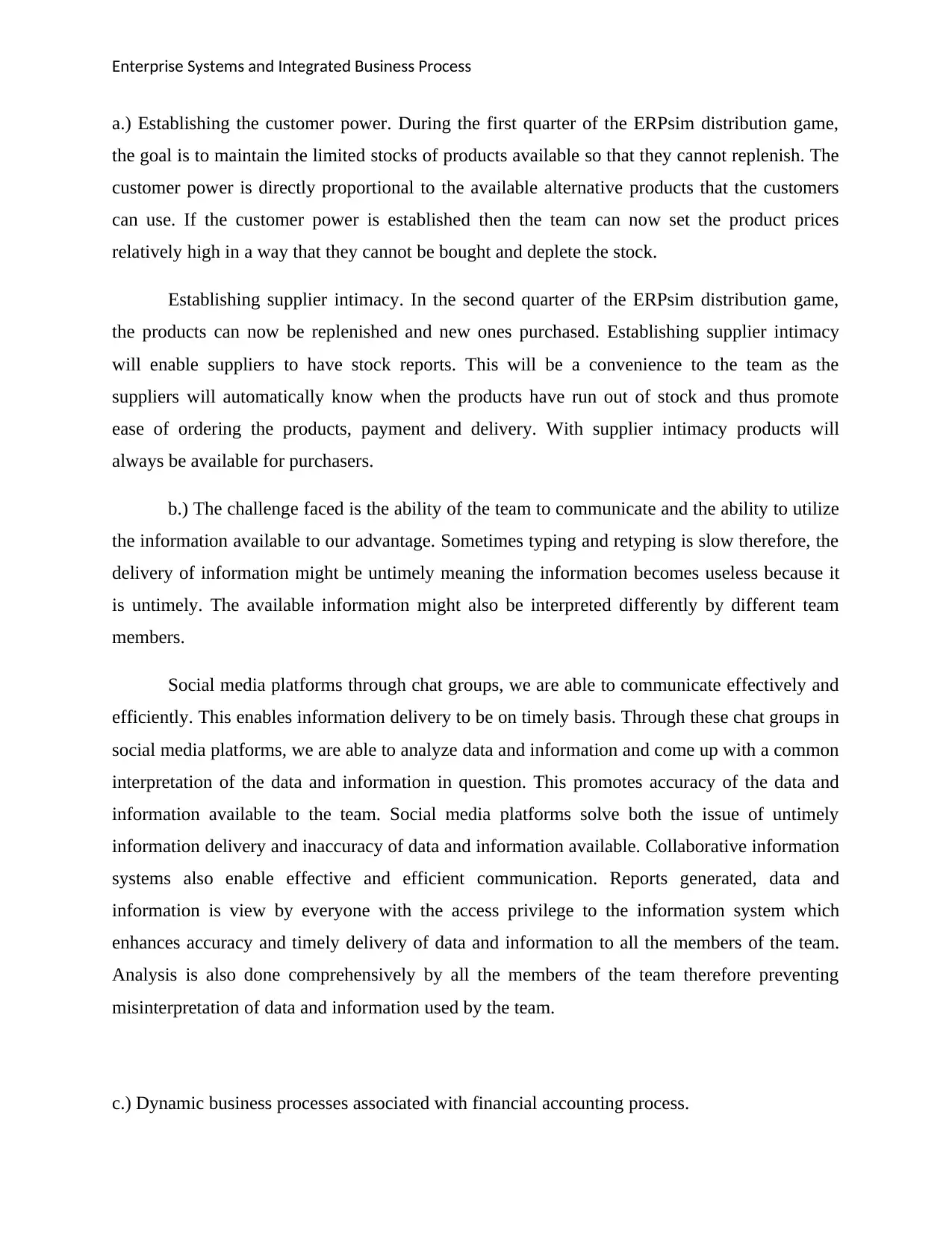
Enterprise Systems and Integrated Business Process
a.) Establishing the customer power. During the first quarter of the ERPsim distribution game,
the goal is to maintain the limited stocks of products available so that they cannot replenish. The
customer power is directly proportional to the available alternative products that the customers
can use. If the customer power is established then the team can now set the product prices
relatively high in a way that they cannot be bought and deplete the stock.
Establishing supplier intimacy. In the second quarter of the ERPsim distribution game,
the products can now be replenished and new ones purchased. Establishing supplier intimacy
will enable suppliers to have stock reports. This will be a convenience to the team as the
suppliers will automatically know when the products have run out of stock and thus promote
ease of ordering the products, payment and delivery. With supplier intimacy products will
always be available for purchasers.
b.) The challenge faced is the ability of the team to communicate and the ability to utilize
the information available to our advantage. Sometimes typing and retyping is slow therefore, the
delivery of information might be untimely meaning the information becomes useless because it
is untimely. The available information might also be interpreted differently by different team
members.
Social media platforms through chat groups, we are able to communicate effectively and
efficiently. This enables information delivery to be on timely basis. Through these chat groups in
social media platforms, we are able to analyze data and information and come up with a common
interpretation of the data and information in question. This promotes accuracy of the data and
information available to the team. Social media platforms solve both the issue of untimely
information delivery and inaccuracy of data and information available. Collaborative information
systems also enable effective and efficient communication. Reports generated, data and
information is view by everyone with the access privilege to the information system which
enhances accuracy and timely delivery of data and information to all the members of the team.
Analysis is also done comprehensively by all the members of the team therefore preventing
misinterpretation of data and information used by the team.
c.) Dynamic business processes associated with financial accounting process.
a.) Establishing the customer power. During the first quarter of the ERPsim distribution game,
the goal is to maintain the limited stocks of products available so that they cannot replenish. The
customer power is directly proportional to the available alternative products that the customers
can use. If the customer power is established then the team can now set the product prices
relatively high in a way that they cannot be bought and deplete the stock.
Establishing supplier intimacy. In the second quarter of the ERPsim distribution game,
the products can now be replenished and new ones purchased. Establishing supplier intimacy
will enable suppliers to have stock reports. This will be a convenience to the team as the
suppliers will automatically know when the products have run out of stock and thus promote
ease of ordering the products, payment and delivery. With supplier intimacy products will
always be available for purchasers.
b.) The challenge faced is the ability of the team to communicate and the ability to utilize
the information available to our advantage. Sometimes typing and retyping is slow therefore, the
delivery of information might be untimely meaning the information becomes useless because it
is untimely. The available information might also be interpreted differently by different team
members.
Social media platforms through chat groups, we are able to communicate effectively and
efficiently. This enables information delivery to be on timely basis. Through these chat groups in
social media platforms, we are able to analyze data and information and come up with a common
interpretation of the data and information in question. This promotes accuracy of the data and
information available to the team. Social media platforms solve both the issue of untimely
information delivery and inaccuracy of data and information available. Collaborative information
systems also enable effective and efficient communication. Reports generated, data and
information is view by everyone with the access privilege to the information system which
enhances accuracy and timely delivery of data and information to all the members of the team.
Analysis is also done comprehensively by all the members of the team therefore preventing
misinterpretation of data and information used by the team.
c.) Dynamic business processes associated with financial accounting process.
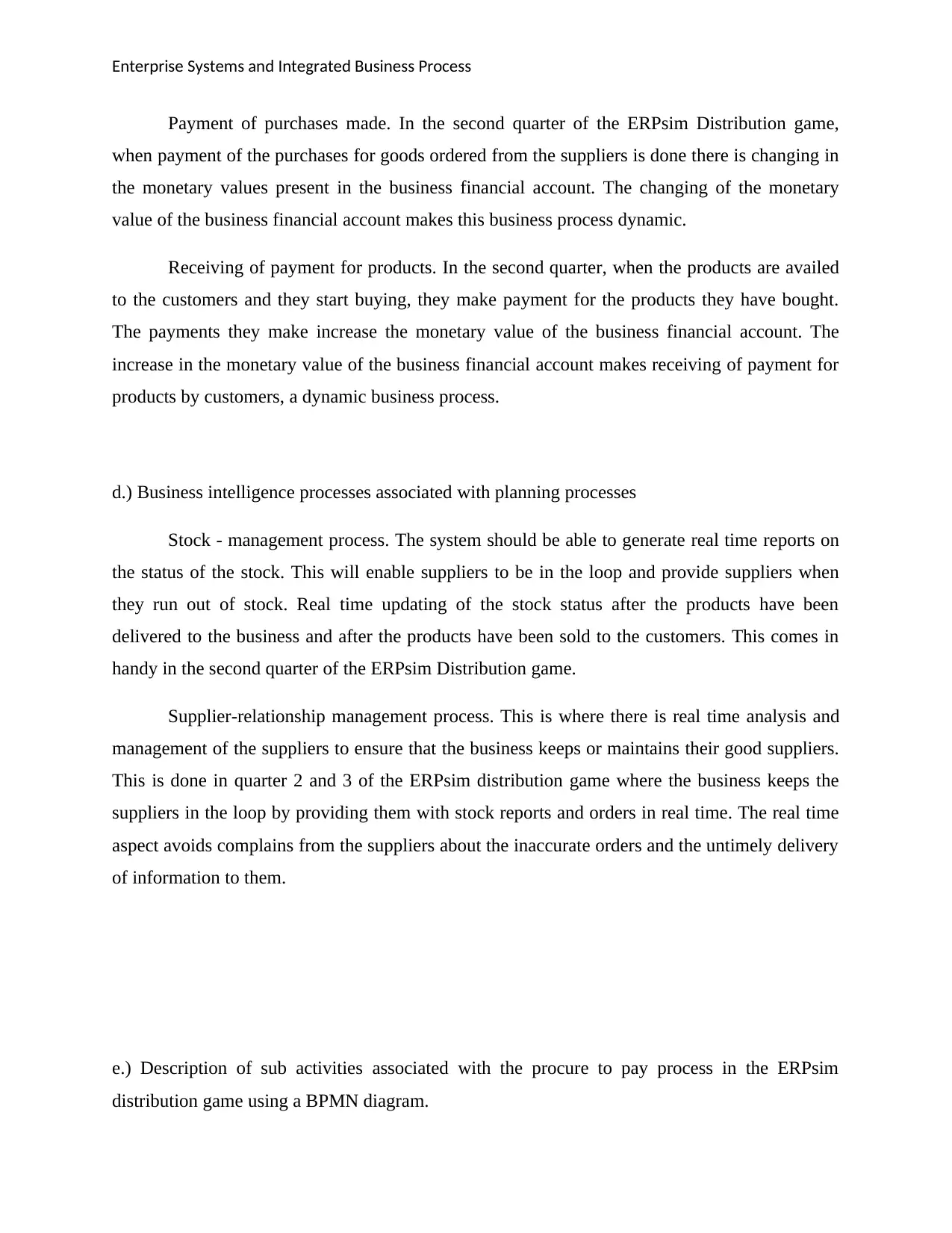
Enterprise Systems and Integrated Business Process
Payment of purchases made. In the second quarter of the ERPsim Distribution game,
when payment of the purchases for goods ordered from the suppliers is done there is changing in
the monetary values present in the business financial account. The changing of the monetary
value of the business financial account makes this business process dynamic.
Receiving of payment for products. In the second quarter, when the products are availed
to the customers and they start buying, they make payment for the products they have bought.
The payments they make increase the monetary value of the business financial account. The
increase in the monetary value of the business financial account makes receiving of payment for
products by customers, a dynamic business process.
d.) Business intelligence processes associated with planning processes
Stock - management process. The system should be able to generate real time reports on
the status of the stock. This will enable suppliers to be in the loop and provide suppliers when
they run out of stock. Real time updating of the stock status after the products have been
delivered to the business and after the products have been sold to the customers. This comes in
handy in the second quarter of the ERPsim Distribution game.
Supplier-relationship management process. This is where there is real time analysis and
management of the suppliers to ensure that the business keeps or maintains their good suppliers.
This is done in quarter 2 and 3 of the ERPsim distribution game where the business keeps the
suppliers in the loop by providing them with stock reports and orders in real time. The real time
aspect avoids complains from the suppliers about the inaccurate orders and the untimely delivery
of information to them.
e.) Description of sub activities associated with the procure to pay process in the ERPsim
distribution game using a BPMN diagram.
Payment of purchases made. In the second quarter of the ERPsim Distribution game,
when payment of the purchases for goods ordered from the suppliers is done there is changing in
the monetary values present in the business financial account. The changing of the monetary
value of the business financial account makes this business process dynamic.
Receiving of payment for products. In the second quarter, when the products are availed
to the customers and they start buying, they make payment for the products they have bought.
The payments they make increase the monetary value of the business financial account. The
increase in the monetary value of the business financial account makes receiving of payment for
products by customers, a dynamic business process.
d.) Business intelligence processes associated with planning processes
Stock - management process. The system should be able to generate real time reports on
the status of the stock. This will enable suppliers to be in the loop and provide suppliers when
they run out of stock. Real time updating of the stock status after the products have been
delivered to the business and after the products have been sold to the customers. This comes in
handy in the second quarter of the ERPsim Distribution game.
Supplier-relationship management process. This is where there is real time analysis and
management of the suppliers to ensure that the business keeps or maintains their good suppliers.
This is done in quarter 2 and 3 of the ERPsim distribution game where the business keeps the
suppliers in the loop by providing them with stock reports and orders in real time. The real time
aspect avoids complains from the suppliers about the inaccurate orders and the untimely delivery
of information to them.
e.) Description of sub activities associated with the procure to pay process in the ERPsim
distribution game using a BPMN diagram.
⊘ This is a preview!⊘
Do you want full access?
Subscribe today to unlock all pages.

Trusted by 1+ million students worldwide
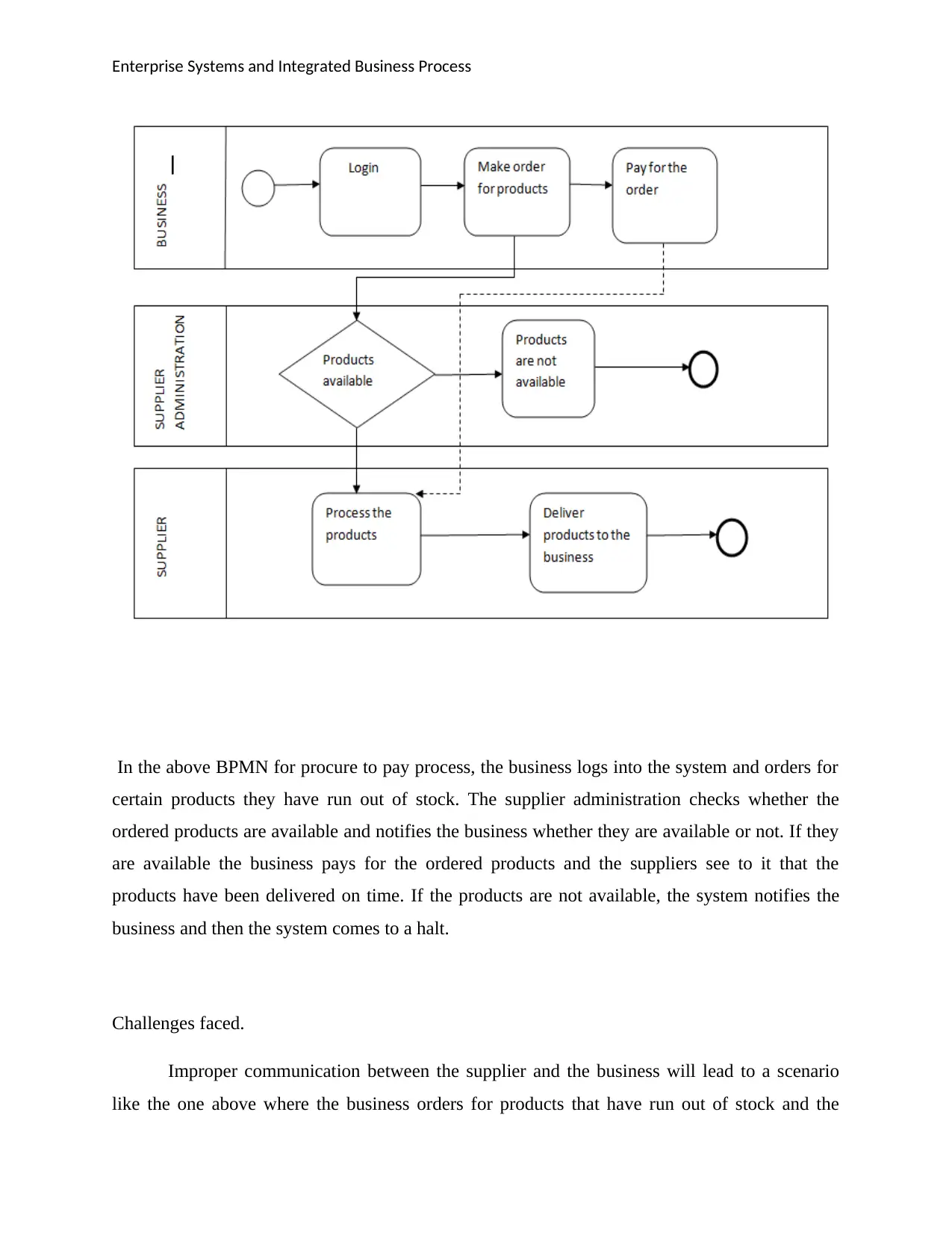
Enterprise Systems and Integrated Business Process
In the above BPMN for procure to pay process, the business logs into the system and orders for
certain products they have run out of stock. The supplier administration checks whether the
ordered products are available and notifies the business whether they are available or not. If they
are available the business pays for the ordered products and the suppliers see to it that the
products have been delivered on time. If the products are not available, the system notifies the
business and then the system comes to a halt.
Challenges faced.
Improper communication between the supplier and the business will lead to a scenario
like the one above where the business orders for products that have run out of stock and the
In the above BPMN for procure to pay process, the business logs into the system and orders for
certain products they have run out of stock. The supplier administration checks whether the
ordered products are available and notifies the business whether they are available or not. If they
are available the business pays for the ordered products and the suppliers see to it that the
products have been delivered on time. If the products are not available, the system notifies the
business and then the system comes to a halt.
Challenges faced.
Improper communication between the supplier and the business will lead to a scenario
like the one above where the business orders for products that have run out of stock and the
Paraphrase This Document
Need a fresh take? Get an instant paraphrase of this document with our AI Paraphraser
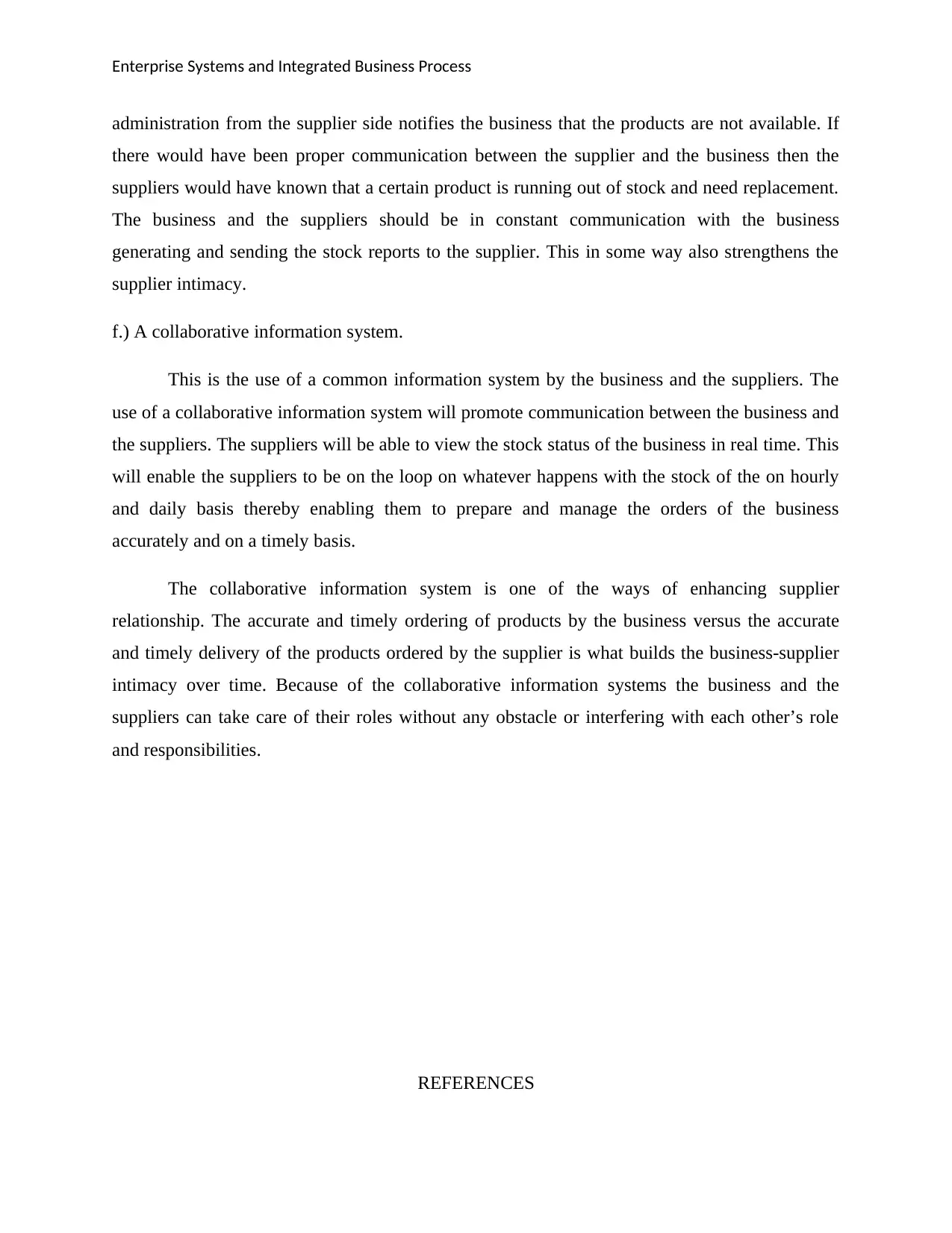
Enterprise Systems and Integrated Business Process
administration from the supplier side notifies the business that the products are not available. If
there would have been proper communication between the supplier and the business then the
suppliers would have known that a certain product is running out of stock and need replacement.
The business and the suppliers should be in constant communication with the business
generating and sending the stock reports to the supplier. This in some way also strengthens the
supplier intimacy.
f.) A collaborative information system.
This is the use of a common information system by the business and the suppliers. The
use of a collaborative information system will promote communication between the business and
the suppliers. The suppliers will be able to view the stock status of the business in real time. This
will enable the suppliers to be on the loop on whatever happens with the stock of the on hourly
and daily basis thereby enabling them to prepare and manage the orders of the business
accurately and on a timely basis.
The collaborative information system is one of the ways of enhancing supplier
relationship. The accurate and timely ordering of products by the business versus the accurate
and timely delivery of the products ordered by the supplier is what builds the business-supplier
intimacy over time. Because of the collaborative information systems the business and the
suppliers can take care of their roles without any obstacle or interfering with each other’s role
and responsibilities.
REFERENCES
administration from the supplier side notifies the business that the products are not available. If
there would have been proper communication between the supplier and the business then the
suppliers would have known that a certain product is running out of stock and need replacement.
The business and the suppliers should be in constant communication with the business
generating and sending the stock reports to the supplier. This in some way also strengthens the
supplier intimacy.
f.) A collaborative information system.
This is the use of a common information system by the business and the suppliers. The
use of a collaborative information system will promote communication between the business and
the suppliers. The suppliers will be able to view the stock status of the business in real time. This
will enable the suppliers to be on the loop on whatever happens with the stock of the on hourly
and daily basis thereby enabling them to prepare and manage the orders of the business
accurately and on a timely basis.
The collaborative information system is one of the ways of enhancing supplier
relationship. The accurate and timely ordering of products by the business versus the accurate
and timely delivery of the products ordered by the supplier is what builds the business-supplier
intimacy over time. Because of the collaborative information systems the business and the
suppliers can take care of their roles without any obstacle or interfering with each other’s role
and responsibilities.
REFERENCES
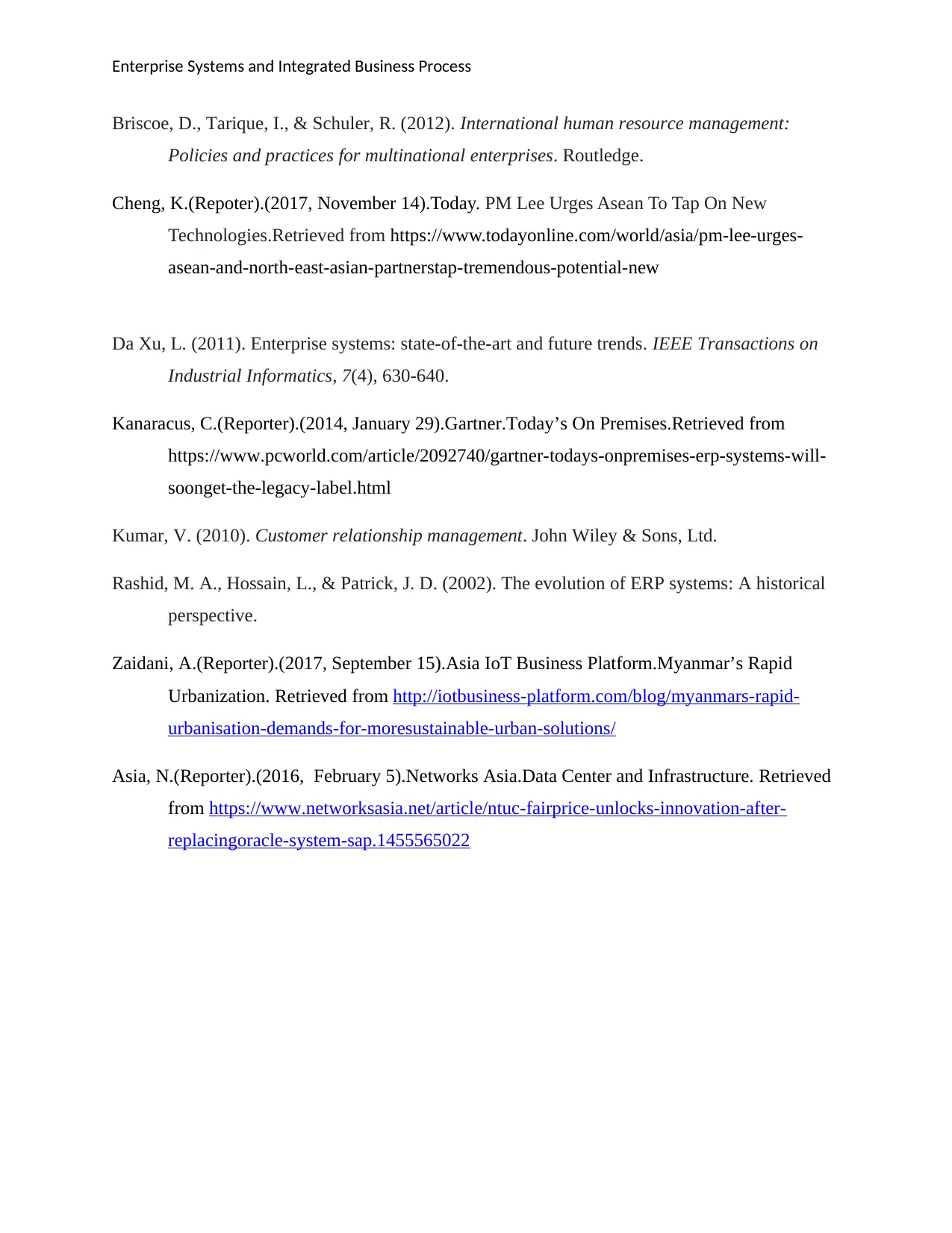
Enterprise Systems and Integrated Business Process
Briscoe, D., Tarique, I., & Schuler, R. (2012). International human resource management:
Policies and practices for multinational enterprises. Routledge.
Cheng, K.(Repoter).(2017, November 14).Today. PM Lee Urges Asean To Tap On New
Technologies.Retrieved from https://www.todayonline.com/world/asia/pm-lee-urges-
asean-and-north-east-asian-partnerstap-tremendous-potential-new
Da Xu, L. (2011). Enterprise systems: state-of-the-art and future trends. IEEE Transactions on
Industrial Informatics, 7(4), 630-640.
Kanaracus, C.(Reporter).(2014, January 29).Gartner.Today’s On Premises.Retrieved from
https://www.pcworld.com/article/2092740/gartner-todays-onpremises-erp-systems-will-
soonget-the-legacy-label.html
Kumar, V. (2010). Customer relationship management. John Wiley & Sons, Ltd.
Rashid, M. A., Hossain, L., & Patrick, J. D. (2002). The evolution of ERP systems: A historical
perspective.
Zaidani, A.(Reporter).(2017, September 15).Asia IoT Business Platform.Myanmar’s Rapid
Urbanization. Retrieved from http://iotbusiness-platform.com/blog/myanmars-rapid-
urbanisation-demands-for-moresustainable-urban-solutions/
Asia, N.(Reporter).(2016, February 5).Networks Asia.Data Center and Infrastructure. Retrieved
from https://www.networksasia.net/article/ntuc-fairprice-unlocks-innovation-after-
replacingoracle-system-sap.1455565022
Briscoe, D., Tarique, I., & Schuler, R. (2012). International human resource management:
Policies and practices for multinational enterprises. Routledge.
Cheng, K.(Repoter).(2017, November 14).Today. PM Lee Urges Asean To Tap On New
Technologies.Retrieved from https://www.todayonline.com/world/asia/pm-lee-urges-
asean-and-north-east-asian-partnerstap-tremendous-potential-new
Da Xu, L. (2011). Enterprise systems: state-of-the-art and future trends. IEEE Transactions on
Industrial Informatics, 7(4), 630-640.
Kanaracus, C.(Reporter).(2014, January 29).Gartner.Today’s On Premises.Retrieved from
https://www.pcworld.com/article/2092740/gartner-todays-onpremises-erp-systems-will-
soonget-the-legacy-label.html
Kumar, V. (2010). Customer relationship management. John Wiley & Sons, Ltd.
Rashid, M. A., Hossain, L., & Patrick, J. D. (2002). The evolution of ERP systems: A historical
perspective.
Zaidani, A.(Reporter).(2017, September 15).Asia IoT Business Platform.Myanmar’s Rapid
Urbanization. Retrieved from http://iotbusiness-platform.com/blog/myanmars-rapid-
urbanisation-demands-for-moresustainable-urban-solutions/
Asia, N.(Reporter).(2016, February 5).Networks Asia.Data Center and Infrastructure. Retrieved
from https://www.networksasia.net/article/ntuc-fairprice-unlocks-innovation-after-
replacingoracle-system-sap.1455565022
⊘ This is a preview!⊘
Do you want full access?
Subscribe today to unlock all pages.

Trusted by 1+ million students worldwide
1 out of 12
Related Documents
Your All-in-One AI-Powered Toolkit for Academic Success.
+13062052269
info@desklib.com
Available 24*7 on WhatsApp / Email
![[object Object]](/_next/static/media/star-bottom.7253800d.svg)
Unlock your academic potential
Copyright © 2020–2025 A2Z Services. All Rights Reserved. Developed and managed by ZUCOL.




